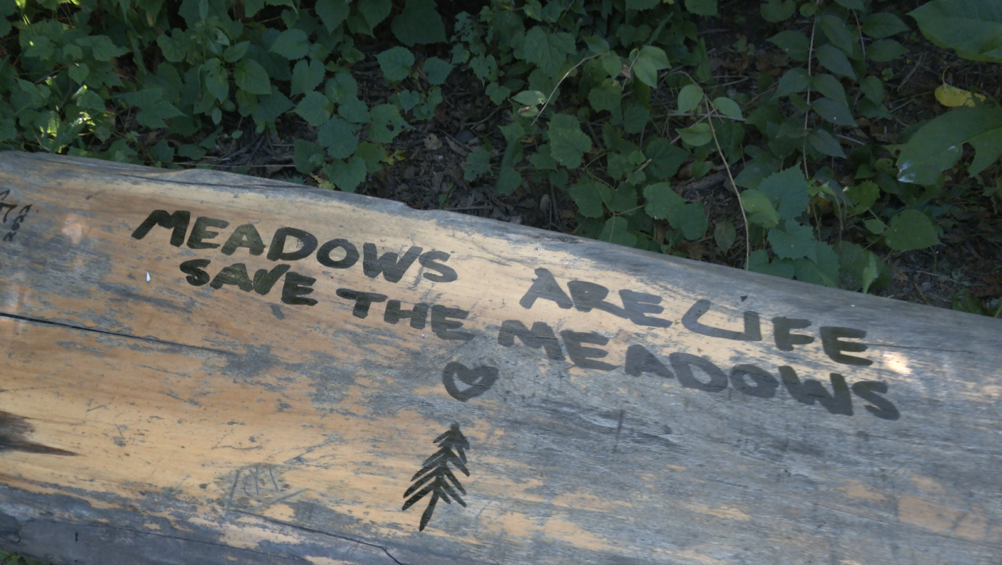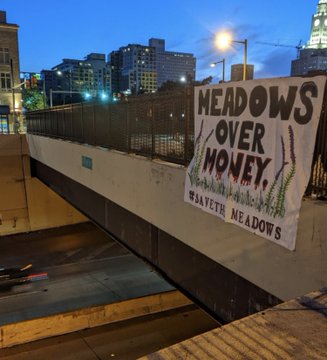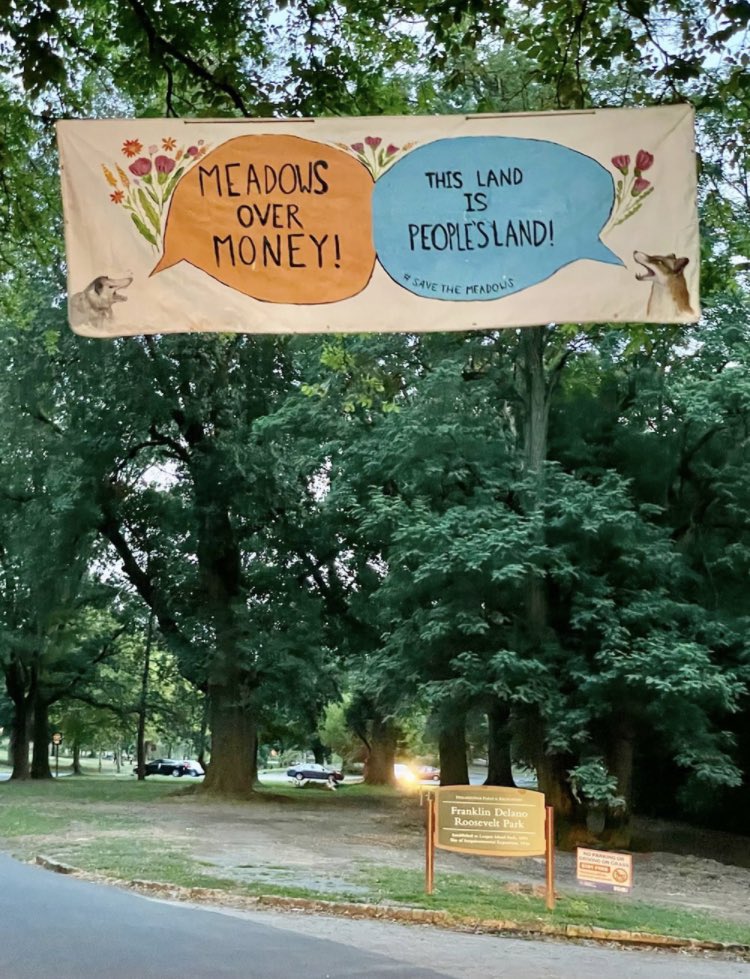Filed under: Development, Environment, Featured, Interviews, Land, Northeast

Interview between anarchist publication Anathema out of so-called Philadelphia and people involved in the struggle to defend FDR park from destruction.
Anathema sat down with two people involved in the struggles to defend the meadows at FDR park in South Philly. What follows is an abridged transcript of the interviews that took place. To read the complete interviews visit the Anathema website anathema.noblogs.org.
Anathema: Can you tell us a little bit about FDR park, the Meadows, and the development taking place there?
1: Yeah, I don’t know about the original history of this park. I know for long term residents of Philly, FDR park is called the Lakes because of the big bodies of water here. I think FDR park was built around these golf courses, and The Meadows was a golf course for a century. It was repeatedly flooded and decommissioned as a golf course in 2018. Although even when it was a golf course, you hear stories about people who have used this land to make a connection to nature. People have stories about foraging all kinds of stuff from South Philly communities. It’s kind of one of the last wild spaces in the South Philly area.
The development that’s taking place here, it’s titled “The Master Plan for FDR Park.” It is an ongoing city plan to raise the elevation of certain areas of the park and add 12 new sports fields. The plan is also connected to development plans with the Philadelphia Airport, which wants to expand and is destroying 40 acres of wetland. By law, it has to restore a comparable amount of wetland. So funds for the redevelopment of this park are funds from the airport to offset the wetland destruction there. They’re also going to “improve” 35 acres of wetlands here at FDR Park.
Anathema: What have the struggles against the development looked like so far? What’s happening?
2: So far, the things that have been happening that I’ve been witness to, have been bulldozing. So just clearing the area of natural trees and wildlife. Fencing it off from the general public who were once able to freely roam around it. The struggle has been trying to find the exact dates of when bulldozing will happen, and also people have done campaigns like phone zaps, and making banners and posters. There have been some events held around the Meadows such as foraging, tree-mappings to try and identify trees and other species within the Meadows to have a perspective on if there are some species that might be endangered.
Basically trying to find ways to halt the destruction. When that didn’t happen, the struggle has looked like more events in the park, more walkabouts, filming. Trying to spread as much awareness as possible. There has been some apparent sabotage of equipment, so you could also say some insurrectionary developments in there as well.
NEW VIDEO: Meadows in South Philly's FDR Park Face Destruction – We toured destroyed, flattened former meadows on August 31st, voids that once hosted teeming insect, mammal and bird life only hours earlier.
Possible herbicide damage shows in some areas – unverified. pic.twitter.com/JDhszY2TxL— Unicorn Riot (@UR_Ninja) September 6, 2022
1: There wasn’t a big offensive push. I think that equipment got staged in late August, and there was push back. People…serviced the machines that arrived *laughs.* I think there were a lot of people doing different things, discussing whether construction people had permits, or thinking of ways to put pressure on the construction company. People trying to put pressure on city officials in ways that had no real effect whatsoever.
At first, when the destruction happened in late August, there wasn’t a clear construction zone. Lots of people were just out and about amongst the destruction, kind of putting themselves at risk in hopes that the construction company would get some kind of retribution for endangering people. That didn’t have much effect. They put up more solid fencing pretty immediately. In the first week of destruction, people were messing with equipment, people may or may not have spiked some trees. That stopped the destruction for a week. The place was swarming with cops and the unusable machinery got replaced.
They did the destruction pretty quickly after that. I feel like they were destroying dozens of acres a day. After a few weeks in which there wasn’t much real material resistance, they had cleared like 70 acres. From what I hear, all they have funding for is this first phase of destruction. As far as I know, now that the first 70 acres are destroyed, there’s gonna be a pause.
Anathema: How have the city, the cops, the neighbors responded to the struggle for the Meadows?
1: The city doubled down on its greenwashing media blasts. The Inquirer and other news outlets are like “The protesters are out of control!” or “Why the city needs the development at FDR Park.” They’re just pushing a narrative that they’re trying to make the space better, of course. Gentrification. They’re trying to make the park welcoming to sports people.
A response from neighbors…I’ve definitely seen people who are used to using the land express heartbreak and dismay that they can’t access the space, that it’s being destroyed.
2: For the most part, the Friends of FDR Park have been going around telling people that they were going to make the Meadows into a different type of area, but that they were going to leave a certain amount for people to still use. Trying to talk about it being more nature. Ultimately it’s being discovered that that’s a lie and not what they were really going to do. The community really enjoys this area, so they have responded like “that’s really fucked up.” But there are still people who believe their master plan, if you will. Because of that, they are under a false assumption that the Meadows will be made into something different and better, so they’re all for the project.
The police response was very minimal at the beginning. As tactics escalated, they responded with a lot more surveillance. It went from a little surveillance, to 24 hour surveillance, to bringing in the FBI. They’ve also brought in the counter-terrorist chain. They’re really trying to snuff out any real sense of eco-justice of an insurrectionary nature.
Anathema: A lot of the land in FDR has already been cleared. Has this changed how people are struggling and what are some of the next steps in light of this clear cutting, leveling, and bringing in dirt
1: I think that once the destruction started and it was kind of clear that we were slow on having both an offensive and a defensive strategy. Once we weren’t able to hold ground anymore, a lot of people were like “Oh fuck, we lost.” I guess it’s real to feel disheartened. People have distanced themselves from this struggle.
There’s still around 100 acres of land that hasn’t been touched, that they plan to develop. There’s still a lot worth defending here. Trying to get ahead of what the developer’s plans are makes sense as a strategy. There could be a long lull until they get enough money to move forward. And continuing to make the project financially unviable for them will always benefit us in trying to stop them.
2: People have definitely had to go and do things a little more under the radar or while knowing there are multiple FBI and security personnel that are constantly watching and trying to analyze where they’re going. There have been rumors of cameras being placed in the park every so often. That’s been a general concern which has deterred a lot of people from coming back into the park. A lot of equipment is now under heavy surveillance or is just off of the grid, so any type of sabotaging efforts have pretty much come to a standstill.
In light of the clear-cutting, the next steps have really just looked like more events in the park, trying to get awareness out there, collaborating with other projects such as the UC Townhomes struggle. Also trying to appeal to the city to stop future leveling efforts.

Source: @kayteterry
Anathema: What would you say to anyone who wants to take part in defending the Meadows?
2: Environmental defense of any kind is important. All ecosystems are important. All matters of wildlife are relatively equal to all of us, we’re not more than any animal that is out there. Ecological defense is very much needed. Any effort you want to give is very much appreciated. I understand people have different comfort levels and ideas, but if you were looking to start somewhere, definitely come out and take a walk around the area. Talk to the local people. Go on instagram. Come get involved, come through to an event.
1: I would say there’s a lot of ways to do that. There are a lot of people invested in this project for whatever reason–annoying them and making their lives difficult is great. I think a lot of people would probably enjoy that. There’s still a lot of open space here to have parties, bring people out. I think A&P construction and the other subcontractors who stand to gain from this project…it definitely makes sense to try to make their lives more difficult.
If you’re looking for offensive or defensive entry points, there are many.
Anathema: Do you think there’s anything people outside of Philadelphia can do to contribute to this struggle?
1: I feel like having solidarity, especially in land defense struggles but I’m thinking in particular urban land defense struggles – like the Atlanta forest, or stopping big development projects. Continuing to boost each others’ struggles and bringing attention to them is bugging the people who stand to gain from them. Those people, those companies exist in different cities. It feels really good, fun, and exciting to be learning from each others’ strategies and boosting each other in those efforts.
Anathema: Is there anywhere people can follow these struggles and keep themselves informed about what’s going on around the Meadows?
1: Yeah, I think the news source I trust the most at the moment about it is the Save the Meadows. They have a website savethemeadows.com. The instagram account is @savethemeadows.
Anathema: What would you say are some strengths and weaknesses of the struggle to defend the Meadows?
1: Some strengths are that our opponents in this struggle–the city, parks and rec, the developers, the cops–are really stupid. The people involved in defending the Meadows are more creative and smarter.
There is a difference in resources, obviously. The city has machinery that can facilitate destruction really fast. The city’s monopoly on violence and destruction is an obstacle to work around. But I feel like there are a lot of artists, smart and brave people involved in the struggle. A disadvantage is that this plan created by the city precedes a lot of our knowledge. They had a big head start.

Source: @kayteterry
2: The struggles for the Meadows really seem to be coming internally in the form of communication, even though there is an instagram and a website. For instance, there was communication of how much is being cleared, but not about how much all at one time. There was speculation of whether there were 100 acres left or less. I would say the struggle of communication is real.
There have definitely been internal struggles. Not everybody is on board with all the tactics that have been used or talked about through this entire movement. There are definitely people trying to control narratives, peace policing, and denouncement of tactics by certain organizers. A struggle is people not getting along or communicating.
Anathema: What are some of the biggest tensions involved in people defending the Meadows?
2: The biggest tension thus far is between organizers and people who are more of a free association, so to speak. People peace policing, people trying to fit a certain narrative or only wanting certain tactics. This has been really frustrating for a lot of people. Organizers have definitely talked a lot of shit on each other. The solidarity is not really there.
And also organizers trying to throw shade, really belittling the work because it wasn’t approved by them. Really trying to go after this narrative of “the movement is 95% white and half of these people are not from the community, so their opinions don’t matter. The ways they choose to enter into the struggle don’t matter.” It’s a real fucking shame because it’s going to show there’s not solidarity amongst everybody, and I think it’s going to turn a lot of people off, if it hasn’t already.
1: Politically, a lot of people involved are still invested in a centralized decision making around what happens here, whether that’s collaborating with the city or having a centralized organization. Of course you don’t have to participate in that, but a lot of organizers are still thinking in terms of how they can get other people to do things instead of doing the things that they want to do, or encouraging people to do the things they want to do. Maybe that’s an issue with how we imagine projects getting done, or how we imagine working together for a shared goal. There is a desire amongst some of the organizers to continue a top down model, and it’s a lot of work to continually challenge that.
photo: Unicorn Riot





